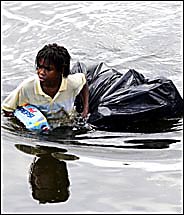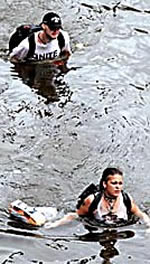
| Write On |
 |
followthemedia.com - a knowledge base for media professionals |
|
|
AGENDA
|
||
The Race Issue Finally Comes to the Forefront in the Katrina Coverage: Can People Be “Refugees” In Their Own Country, and How Come One Picture Caption Identifies a Black as a Looter While a Similar Picture of a White Does Not?When New Orleans was ordered evacuated, those who stayed for the most part had no way of escaping. They were either ill or poor or just did not have the means to escape. And most of the poor were black. That was obvious on our television screens but reporters didn’t talk about that much.With a population of some 445,000, about two-thirds were black. And of those 300,000 blacks about 30% lived below the poverty level, meaning about 90,000. So that explains why there were thousands of people, mostly black, camped out at the Superdome and the convention center. And it was these people who for days didn’t get the food, water, sanitary conditions, and security that they desperately needed. Television reporters started to compare their pictures of misery and degradation to the videos of past events they had seen from Africa and Third World countries and before long someone used the word “refugee” and before you knew it almost everyone was using it. And that caused a ruckus within the Black political community that firmly declared that citizens could not be refugees in their own country and they urged the media to stop using the word. It was actually one of the few times that Black leaders and President Bush have agreed, for he said, “The people we are talking about are not refugees. They are Americans.” Still the word kept being used, but NBC’s Brian Williams announced at midweek that NBC would no longer use the word refugee and would instead use evacuee or survivor.   Who is the looter and who found the food bags floating?A furor has also broken out about two pictures, one from Associated Press (AP) and the other from Getty Images, distributed by Agence France Presse (AFP) that showed similar scenes -- people wading in flooded streets with bags of food floating. The AP picture, showing a black man, called him a looter, the Getty picture showing a white couple with a woman holding bags of food said they were shown after finding bread and sodas from a local store. They were not called looters. Both pictures showed up on Yahoo and within short order the racist charge was being leveled – If a person was black the media said they were looting but if they white then they found the food and were not looters. Since the pictures came from separate agencies it was difficult to make a racism charge stick. The AP photographer said he saw his subject wade into a grocery store and come out with the goods. In most people’s definitions that would be looting, although in New Orleans, due to a lack of food and water supplies in the first week there seems to be sympathy that if people took food then that was survival; if they took something to plug into the wall socket then that was looting. In the case of the white couple, the Getty photographer said he saw items floating in the flood near where a grocery store’s door had opened. He drew the conclusion they had not entered the shop but had picked up the items floating by, thus no use of “looting”. But for those who watch such things this was a media double standard at work. In fact the Yahoos of this world that take direct feeds of pictures with the accompanying captions and have them flow automatically onto their sites without any further editing are taking some risks. With most international picture services running 1,000 or more pictures a day, the days when their editors would closely look at every picture, study every caption, take time to crop that picture and then send it on its way are long gone. It might happen still in a few instances, but they are few and far between. More and more international news agency photographers are now given direct filing rights for their pictures, bypassing editing desks and sending their pictures directly to the network. And for those pictures that do get stopped in an editing center the truth is there are so many pictures and not enough editors that usually there is a cursory look and the picture is sent on its way. One subject where pictures might be at a premium is the recovery of bodies. The New Orleans Mayor believes thousands may be found drowned in their homes, but the Bush Administration says that it does not want the media taking pictures of the dead and therefore will not allow photographers on their rescue boats.
A spokesperson for the Federal Emergency Management Agency (FEMA) said the no pictures policy was to ensure that victims would be treated with dignity and respect, a similar policy which it applies to body bags returning from Iraq. But with the stress of policemen who may have lost their own homes and/or family members trying to keep the peace against looters and random shootings, it seems that the press may also be targets, too. Reporters and photographers are complaining of rough treatment by New Orleans police officers, according to Reporters Without Borders, Toronto Star reporter Tim Harper and photographer Lucas Oleniuk were roughed up by police as they covered a clash with looters. Police threatened them several times and then hurled Oleniuk to the ground, grabbed his cameras, and removed memory cards holding about 350 pictures. In another incident a New Orleans Times-Picayune reporter was detained and his equipment smashed as he covered police dealing with local residents. He fled not only the scene, but also the city that same day. Coverage of New Orleans and its aftermath will continue for some time to come. The television networks saw their news ratings grow by about 50% and their news specials often won their time period. The cable news networks have gotten huge audience increases (Fox up 142% over July, and CNN, still trailing but up a whopping 466%). They’re not about to let go of a story like this. Media organizations such as the New York Times are opening bureaus in Baton Rouge. Texas has 250,000 people within its borders it didn’t have 10 days ago and many of them say they don’t intend to go home. It could mark one of America’s biggest migratory moves, which could in itself be very destructive to the Big Easy. Why rebuild if people won’t live there? In Washington the politicians are out for Republican blood; the Republican Congressmen sensing they could be in trouble at the next election are distancing themselves from the government’s relief efforts and criticizing those efforts as much as the Democrats. President Bush has already sent Congress another appropriation for $50 billion for Gulf Coast relief on top of the $10 billion Congress has already approved, and questions are already being asked if the country can afford that type of unbudgeted expense and also Iraq. Add to that the dramas that will unfold at Congressional hearings into what went wrong. Katrina spent only a few hours in the Gulf Coast, but the real soul-searching into what it did to the US as a nation has yet to begin. It won’t be pretty. Stay tuned. |
| copyright ©2005 ftm publishing, unless otherwise noted | Contact Us • Sponsor ftm |